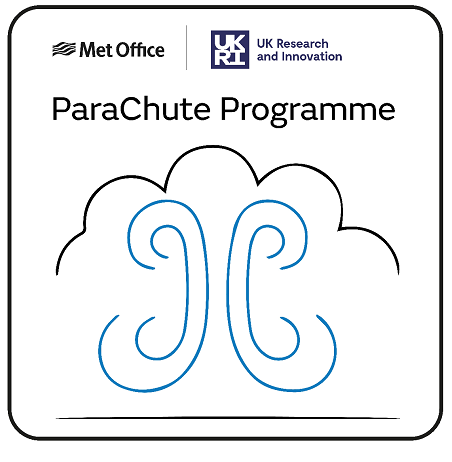ParaChute - Representing turbulence in models
ParaChute is a four-year programme of work jointly funded between UKRI and the Met Office with the aim of significantly improving the representation of turbulence in km and sub-km scale models.

Representing turbulent atmospheric processes
Weather and climate models are critical to society’s ability to reduce the impacts of hazardous weather, helping to inform decisions on adapting to climate change, and provide advance warning of high-impact weather. The accuracy and value of these models can be improved by increasing their horizontal resolution. When grid boxes are kilometres, or in some cases hundreds of metres in length, they provide representation of the surface terrain, and simultaneously capture cloud-scale motions and long-range atmospheric flows.
By moving to km and sub-km resolutions, the representation of turbulent processes in the atmosphere is partially resolved, with energy needing to be exchanged between the resolved grid and the sub-grid physics (a difficult problem known as modelling in the “grey zone”). In addition, as turbulent motions are inherently stochastic, weather forecasts and climate models carry uncertainty that needs to be quantified to provide value to decision makers.
Methods for modelling turbulence in this “grey zone” are still in their infancy. The key problems are the lack of model convergence at different resolutions, and the unrealistic emergence of structures (aliasing) onto the grid scale, leading to systematic biases in projections. A faithful representation of the grey zone is vital for ensuring the accuracy of predictions of severe weather.
ParaChute and its projects
ParaChute is an £11m programme jointly led by the Met Office and UKRI and running over four years from February 2023. It also involves researchers from the Universities of Exeter, Leeds, Reading, Manchester and Imperial College.
Following a funding opportunity, five projects were selected by Natural Environment Research Council (NERC) to work with Met Office scientists on improving these models. These were:
- WOEST (Principal investigator (PI): Ryan Neely, NCAS, University of Leeds). This project was designed to supplement and complement the Met Office WesCon observational campaign, which took place in Summer 2023. It targets precipitating convective cores, measurement of the eddy dissipation rate, and conditions linked to the pre-convective environment and its variability.
- Hi-Fi (PI: George Efstathiou, University of Exeter). This project aims to develop a dynamically-adjusting length scale for closing turbulence models, eventually coupling it to higher-order turbulence representations.
- UMBRELLA (PI: Andrew Ross, University of Leeds). This aims to evaluate current and future boundary layer schemes in the grey zone, and to understand how to include the effects of heterogeneity and topography into future schemes.
- MORPH (PI: Bob Plant, University of Reading). This project aims to contribute to the inclusion of stochastic and scale-aware behaviour in CoMorph, targetting km scales. It will also work on steps towards unification between mass-flux and turbulence schemes.
- CloudyTime (PI: Thorwald Stein, University of Reading). This project aims to evaluate observations from WesCon with modelled convective turbulence; investigate introducing turbulence-microphysics coupling; and assess controls on predictability over the WesCon domain.
The projects were combined with work-packages from the Met Office to form an overall programme, led by Alison Stirling and Humphrey Lean at the Met Office.
ParaChute working groups
- WesCon-WOEST observational campaign: an observational campaign called WesCon was conducted in Summer 2023 to inform understanding and representation of turbulence in a variety of conditions. This campaign underpinned the modelling and evaluation used in ParaChute.
- Turbulent grey zone: the group aims to produce a new representation of turbulent mixing that better represents the transfer of energy across the grey-zone.
- Convective grey zone: the aim of this working group is to produce a scale-aware, stochastic representation of convection at km scales that works seamlessly with the turbulence scheme and improves precipitation structures and the thermodynamic state at km scales.
- Microphysical interactions with turbulence: this group is exploring inclusion of a more direct link between turbulent collisions and the precipitation accretion process.
- Physics-dynamics coupling: this group aims to quantify the role of the dynamics representation in representing turbulent processes.
- Predictability: this group aims to quantify the upscale transfer of uncertainty, due to turbulent processes, and use to develop new methods for creating ensembles.





